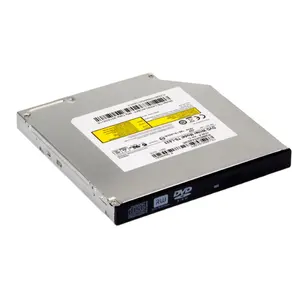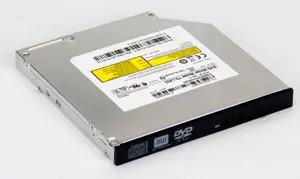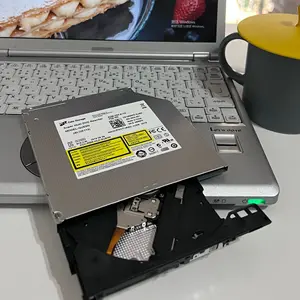
All categories
Featured selections
Trade Assurance
Buyer Central
Help Center
Get the app
Become a supplier

(185 products available)


















































A CD burner machine or CD-ROM write machine is a device used to inscribe or create compact disks (CDs) by transferring information onto a CD, henceforth commonly referred to as a CD. The process of creating CDs is referred to as burning.
CD-ROM writing devices have, over the years, become an important part of many businesses, libraries, and educational establishments, among many others. They are also referred to as CD recorders, compact disk recorders, disk burners, or simply burner. These machines are a good substitute for the much less practical floppy disks and are preferred by many because of their storage capacity and durability.
CD burner machines come in all shapes and sizes, varying from one another according to distinctive features such as speed, type of drive, and the number of drives. Regardless of these differences, they all perform the same function – burning data onto a compact disk.
Whether buying a CD burner machine for personal use or business endeavors, it is important to note some key differences between the machines that can aid in making an informed decision. The following are some of the most common types of CD burner machines:
External CD burners
External CD burners are compact peripheral devices that are connected to a computer using a USB or FireWire cable. They are portable and can be moved from one place to another with ease. For this reason, external CD burners are most commonly used in businesses and offices. They can also be used in schools and libraries, where a number of computers require access to a single CD burner.
Internal CD burners
Unlike external CD burners, internal CD burners are fixed devices that are installed inside a computer's DVD drive bay. They are not portable and cannot be used by more than one user at a time. Internal CD burners have faster data transfer speeds than external ones.
Stand-alone CD burner machines
They are also known as desktop CD burners. Unlike the internal and external CD burners, they do not rely on a computer. Stand-alone CD burner machines provide a quick and efficient way of creating compact disks without depending on a computer or network connection.
CD burner machines have various functions and features that make them versatile for different uses.
Burning CDs
The primary function of a CD burner machine is to write, or ""burn,"" data onto a blank CD. This process involves using a laser to etch the digital information onto the disc. CD-burning software allows users to select the files they want to burn, choose the recording speed, and create the disc.
Data Verification
Many CD burner machines have data verification features. This ensures that the data has been accurately written onto the disc. The machine will check that all the bits and bytes have been correctly encoded to avoid errors or corrupt files.
Multi-format Support
CD burner machines can support multiple formats, such as audio CDs, data CDs, and MP3 CDs. This allows users to create discs in different formats depending on their needs. For instance, an audio CD format can be used to play music in the car, while a data CD format can be used to store documents or pictures.
High-Speed Burning
Some CD burner machines have the capability of burning CDs at high speeds. Users need to be careful when using this feature, as high-speed burning can sometimes lead to errors or reduced compatibility with some CD players.
Disc Types
CD burners can work with different CDs, including compact discs-reWritable (CD-RWs), compact discs-recordable (CD-Rs), and digital versatile disks (DVDs). With this feature, users can choose the type of disc that best suits their needs for burning.
Buffer Underrun Protection
Buffer underrun protection is an important feature of CD burner machines. This protects the CD from becoming corrupted if there is a temporary interruption in data flow during the burning process. It allows the machine to resume writing without error if the computer is busy or the buffer memory runs low.
Audio CD Compilation
Many CD burner machines provide features for compiling and organizing music tracks into playlists before burning them onto an audio CD. This makes it easy to create customized playlists with preferred settings.
CD Labeling and printing
Some CD burning software has labeling and printing features. This allows users to design labels for their burned CDs directly from the CD burner machine. They can add text, such as the disc title or date, and choose to print with or without a CD printer.
Simply put, a CD burner machine is used to create CDs. It does this by either saving the data on the disk or making sure that the data is in the machine's desired format. The main function of this device is to create CDs, but it can also create DVD's.
This machine can be used in various industries, but some commonly mentioned ones are music and gaming. Here, it is used to create copies of the content so that they can be sold in stores or used in all the mentioned industries.
Companies usually use CD burner machines when they need to create multiple copies of data in a short time. If the data is in a digital format, the machine can quickly convert it to an audio CD.
This device can come in handy when storing backups. In a world where digital storage systems can fail, having physical backups is wise. These machines can help a company or an individual create physical backups of their important data.
The CD burner machine can be used to create promotional content or products by burning the final versions of the content that are to be released onto disks. Moreover, this machine can be used in education to create course material or any other kind of material that is needed for a specific course.
The market for CD burners is vast, with many different makes and models available. When choosing which one to purchase for a business, it is important to consider the following:
Q: What are the steps to use a CD burner machine?
A: The process of using a CD burner machine may differ depending on the model. However, the following steps are often common. Insert a blank CD into the burner, then open the CD burning software. Select the files to be burned onto the CD and choose the burning options. Finally, click on the burn button to start the burning process.
Q: How can someone ensure successful CD burning?
A: To ensure successful CD burning, one should use high-quality blank CDs, keep the computer and burner machine updated, avoid multitasking during the burning process, and verify burned CDs.
Q: How long does it take to burn a CD?
The time taken to burn a CD depends on various factors, such as the speed of the CD burner machine, the amount of data to be burned, and the type of media. However, burning a standard audio or data CD at 1X speed takes approximately 5-7 minutes.
Q: What is the lifespan of a CD burner?
The lifespan of a CD burner machine highly depends on usage, handling, and environmental conditions. Typically, it can last for several years. However, it may require replacement parts due to wear and tear like any other electronic equipment.